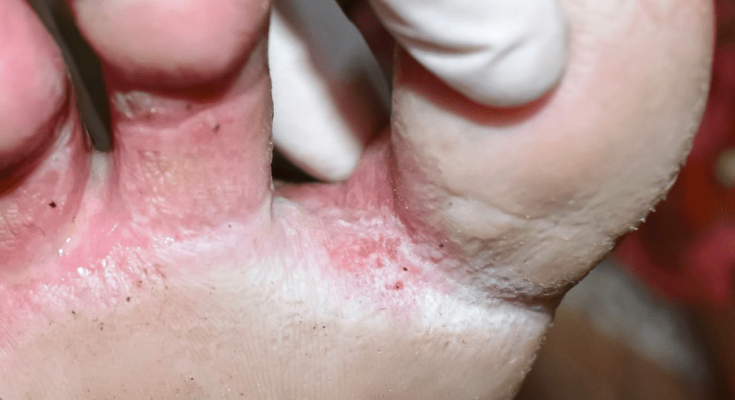Fungal infections between the toes, often called athlete’s foot or tinea pedis, are a common nuisance for many. They thrive in warm, moist environments—exactly the conditions your feet experience in tight shoes or after intense physical activity. If you’re dealing with this uncomfortable issue but can’t seek medical advice right now, don’t worry. There are several effective over-the-counter remedies and preventive measures you can try at home to get relief.
What Causes Fungal Infections Between the Toes?
Fungal infections are caused by dermatophytes, a type of fungus that feeds on keratin, the protein in your skin. These fungi flourish in areas with limited airflow and high moisture. Wearing damp socks, walking barefoot in communal areas like locker rooms, or even minor skin injuries can create a perfect breeding ground for these pesky invaders.
Certain factors, like a weakened immune system, diabetes, or excessive sweating, can increase your risk. Athletes and those frequently engaged in physical activities are particularly prone, as their feet often remain sweaty for long periods.
Common Symptoms to Watch For
Not sure if you’re dealing with a fungal infection? Look out for these telltale signs:
- Persistent itching or burning between the toes.
- Red, scaly, or cracked skin in the affected area.
- Blisters that may ooze or crust over.
- An unpleasant odor due to trapped moisture and fungal growth.
If you notice these symptoms, it’s time to take action before the infection worsens or spreads.
Top Over-the-Counter Remedies for Toe Fungal Infections
Fortunately, mild to moderate fungal infections can often be treated effectively with OTC remedies. Here’s what you need to know about the most popular options:
- Antifungal Creams and Ointments
Products containing active ingredients like clotrimazole, miconazole, or terbinafine are your best bet. These creams and ointments work by killing the fungus and soothing the irritated skin.- How to Use:
Clean and dry the infected area thoroughly. Apply a thin layer of the cream to the affected skin and surrounding areas, usually once or twice daily. Continue using the product for the full duration recommended on the packaging—even if symptoms disappear early.
- How to Use:
- Antifungal Powders and Sprays
These products are excellent for keeping the feet dry and preventing the fungus from spreading. Powders absorb moisture, while sprays can reach hard-to-access spots between the toes.- When to Use:
Combine powders or sprays with creams for a comprehensive treatment approach. You can also apply them to your shoes to eliminate any lingering fungus.
- When to Use:
- Antifungal Solutions and Gels
If creams or powders feel messy, liquid solutions or gels may be more convenient. These formulations are easy to apply and quickly absorbed.
Home Remedies for Natural Relief
If you prefer natural alternatives, several home remedies may offer some relief. While their effectiveness can vary, they’re worth a try for mild cases:

- Tea Tree Oil: Known for its antifungal and antimicrobial properties, tea tree oil can be diluted with a carrier oil and applied to the affected area.
- Vinegar Soaks: A foot soak made from one part vinegar to four parts water may help restore the skin’s natural pH, making it less hospitable for fungi.
- Garlic: Crush a few garlic cloves and mix them with olive oil to create a paste. Apply it to the infection for its natural antifungal properties.
Important Note: While these remedies are generally safe, they should not replace proven antifungal treatments for severe infections. Always test natural products on a small patch of skin first to check for allergies.
Preventing Future Fungal Infections
Prevention is just as important as treatment. To keep fungal infections at bay, follow these tips:
- Keep Feet Clean and Dry
Wash your feet daily with soap and water, then dry them thoroughly—especially between the toes. Moisture is the enemy of healthy skin. - Choose the Right Socks and Shoes
Opt for breathable, moisture-wicking socks and shoes made from materials like leather or mesh. Avoid wearing the same shoes two days in a row, and let them dry out completely between uses. - Disinfect Regularly
Use antifungal powders or sprays inside your shoes and on your feet to create a protective barrier. Wash socks and towels in hot water to kill any lingering fungus. - Avoid Walking Barefoot in Communal Areas
Wear flip-flops or shower shoes in gyms, pools, or hotel rooms to reduce your exposure to fungal spores.
When Over-the-Counter Remedies Aren’t Enough

If your symptoms persist after a few weeks of treatment or if the infection spreads, it’s time to consult a healthcare professional. Severe cases may require prescription-strength antifungal medications, such as oral tablets or medicated creams. Additionally, recurrent infections may signal an underlying health issue that needs attention.
Conclusion: Take Charge of Your Foot Health
Dealing with a fungal infection between your toes can be frustrating, but with the right approach, you can tackle it effectively. Over-the-counter remedies, when used consistently, are highly effective for mild to moderate cases. Combine these treatments with proper foot hygiene and preventive measures to stop the infection in its tracks and prevent future occurrences.
Remember, even the smallest changes—like switching to breathable socks or drying your feet carefully—can make a big difference. Take control of your foot health today and say goodbye to fungal infections for good!



